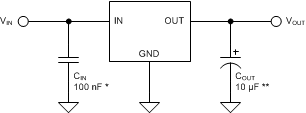The title is just for comic effect. Zeners have a valid place in at least clickie drivers. They, however, present cell damage risk in momentary switch lights due to large parasitic drain. Forgetting to lock out can result in your cells' voltages going into the danger zone in short order. I've turned many of my buck drivers (that don't have zeners but use diodes to regulate voltage and provide reverse polarity protection) in to momentary switch drivers and they all have horrendous parasitic drain.
If your shopping for a new driver with low parasitic drain RMM and led4power have some great options.
For existing drivers, a very nice solution is readily available and somewhat easy to implement.
It's the LM2936. It marketed as an "Ultra-Low Quiescent Current LDO Voltage Regulator". It has less than 15-μA quiescent current at a 100-μA load. It was mentioned in here by texaspyro, but no one seems to have reported trying it out. The data sheet looks real good to me. It also has built in reverse polarity protection.
Started playing with one. Man, it has rock solid voltage output. Voltage only varied 10mV from input of 9V to input of 18V. Very nice. None of my drivers come even remotely near that. It can take up to 40V input in the normal model! Oh yeah, this baby is going in all my >1S drivers.
Here is the recommend circuit to implement with it.

The 10uF caps already on our drivers should be way over kill in covering the input requirement. It's advisable to got to higher voltage rated caps though. I have like 500 10uF 50V X7R's on the way. I will probably try to sell off a good chunk of them. I intend to solder the + and - pins to each side of the cap on most of my drivers.
The datasheet says it is essential that the output capacitor meet the capacitance and ESR requirements, or oscillations can result. Ceramic capacitors can be used only if a series resistor is added to simulate the ESR requirement. Typically, a 500-mΩ to 1-Ω series resistor is used for this purpose. The suggested resistor in series with the output cap is not shown in the above diagram because you can also buy caps with the proper ESR.
It comes in several package options including:
TO-92
4SOT-223
8SOIC
8VSSOP
TO-252
I ordered two different package types of the 5 volt version. I purchased the T0-92 package here. I will use the TO-92 package for converting existing drivers as the long pins will provide flexibility built in air wires. I found that I could easily solder the SMD caps and resistor to the top of the pins if needed. I purchased the SOT-223 package here. I haven't used these yet. I intend to design some boards that will use them. They are much bigger than 7135's.
Pilotdog68 rendered this drawing to show me how much bigger the SOT-223 is than the AMC7135 SOT-89. Probably will be limited to bigger boards.

I'll be documenting the various drivers I put it in here. How to and results.
- First up was a HX-1175b1 in Post 16. Will be used with 4S cells to drive an MT-G2 with a momentary switch. LVP resistors are 100K for R1 and 5.6K for R2.
- Wight's 22mm DD+7135 in Post 35. Will be used with 2S3P cells driving 2S6P emitters.

 You made me just realize I have been misspelling Zener.
You made me just realize I have been misspelling Zener. I thought you were just mis-spelling zener for added comic effect! We don’t need no stinking Zeners!
I thought you were just mis-spelling zener for added comic effect! We don’t need no stinking Zeners!